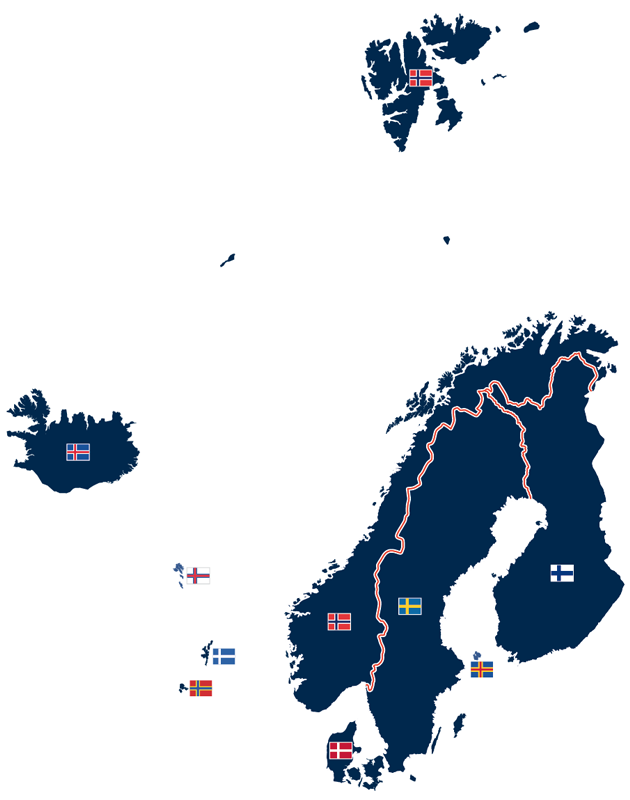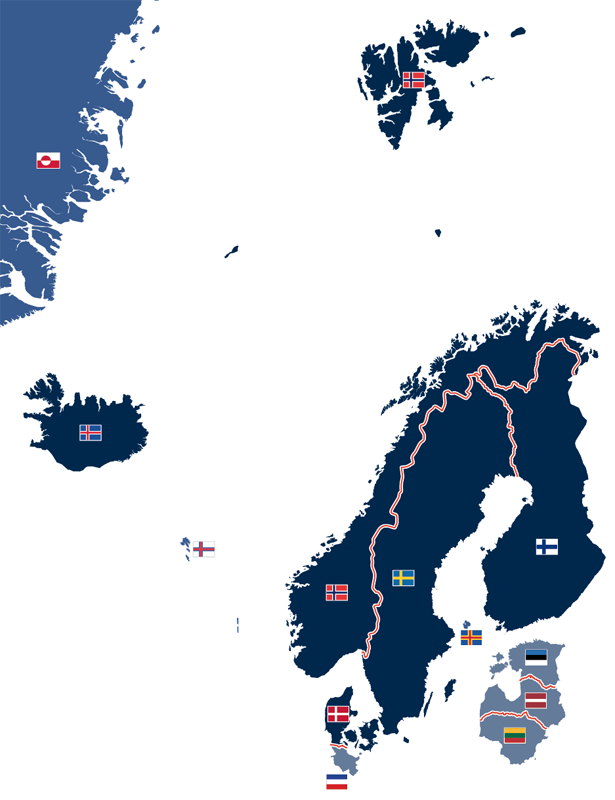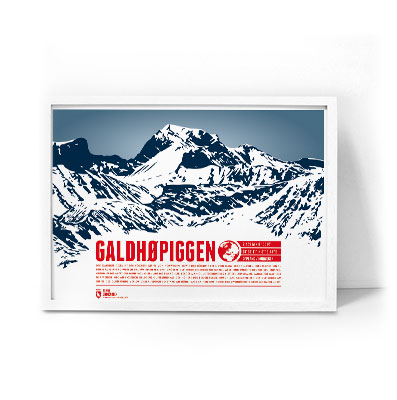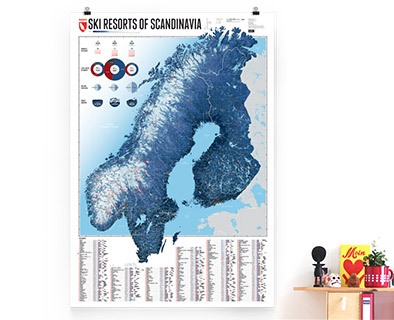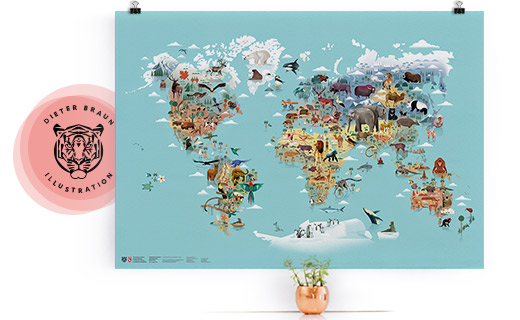Scandinavia is in northern Europe. But where exactly are its borders and which countries are regarded as Scandinavian countries? What about Scandinavian languages and the flags with the Scandinavian Cross? Learn more about Scandiavia and the countries of northern Europe here.
In most definitions “Scandinavia” is defined as the area of the Scandinavian Peninsula in Northern Europe, which is dominated by the Scandinavian Mountains (see for example Wikipedia or Encyclopædia Britannica).This means that Norway and Sweden are clearly Scandinavian countries. The northeastern border of the Scandinavian Peninsula is not clearly defined. Northern Finland and most of Finnish Lapland do undoubtedly reach into the Scandinavian Peninsula and Mountains.
The most northern point of Scandinavia is the Nordkap in Norway. In the south of the country is Scandinavia's highest peak, the Galdhøpiggen with an elevation of more than 2,400 meters.
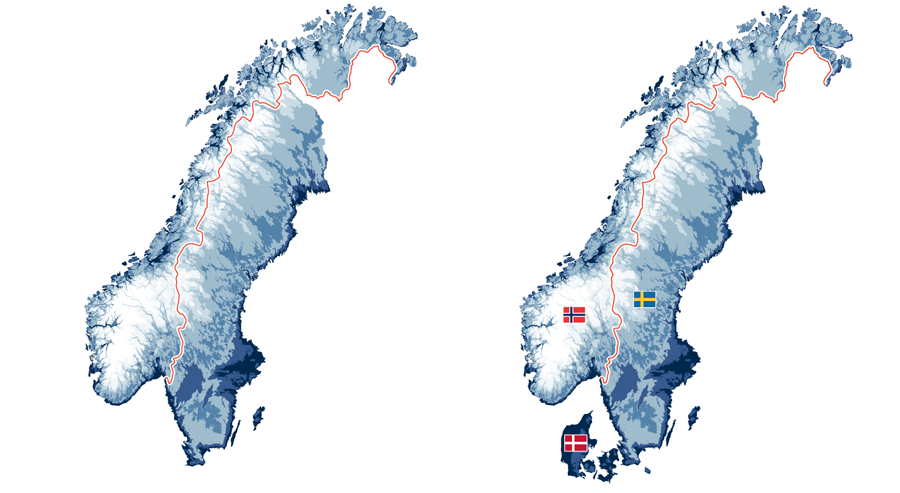
left: Scandinavian Peninsula with Norway and Sweden.
right: The “usual” Scandinavian countries Norway, Sweden, and Denmark.
The issue with a proper definition for “Scandinavia” is clearly that geographical and cultural elements are usually combined. Depending on which aspects you stress, this leads to different results, when determining which countries should be regarded as part of Scandiavia.
Denmark is mostly regarded as one of the Scandiavian countries, which has foremost linguistic, historic, and overall cultural reasons. The Danish autnomous areas of the Faroe Islands and Greenland are viewed separately, though. In pure geographical terms there would be a lot of ground to claim Denmark to be Central Europe's most northern part and perhaps a transition area to Scandinavia. Depending on your point of view regarding Denmark, Scandinavia's most southern point is either at Smygehuk in Trelleborg in southern Sweden, or on the Danish island Falster in the Baltic Sea.
Finland is less frequently counted as part of Scandinavia than Denmark, even though, as stated above, geographically there is a lot of reason to count at least the country's north as part of it. The Finnish history is closely intertwined with that of Sweden in particular, since the country was under Swedish rule for centuries.
Iceland also has close linguistic and historic ties with Scandiavia and is therefore sometimes also seen as part of a Scandinavian or Nordic cultural community of values, even though the island on Europe's outmost margin is situated almost 1,000 kilometers away from the Norwegian coast.
Northern Europe and Fenno-Scandinavia
As stated above the Scandinavian Peninsula's northeastern border is not clearly defined. Sometimes a larger area named Fenno-Scandinavia, or Fennoscandia is regarded. Besides the Scandinavian Peninsula it also contains all of Finland (“Fenno”) and the Russian territories of the Kola Peninsula and Karelia.
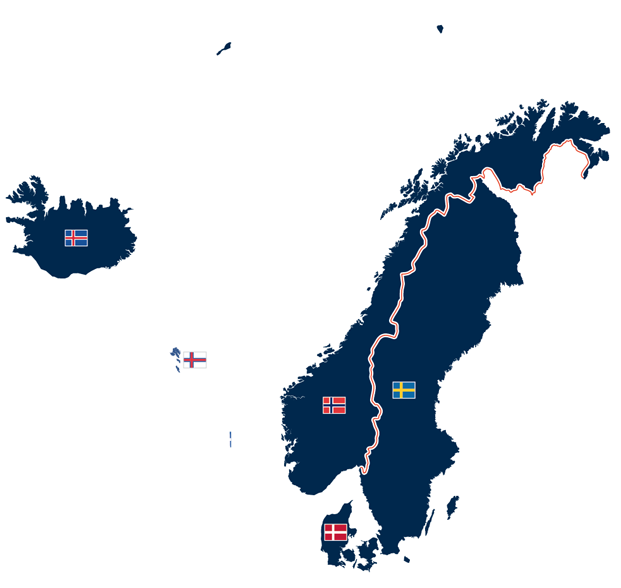
Besides the Scandinavian languages
Faroese and Icelandic are also part of the family of Nordic languages.
Scandinavian and Nordic languages
Denmark, Sweden, and Norway are not only geographically close to each other and have a rich common history. Also their languages are quite similar and usually Danes, Swedes, and Norwegians can easily communicate with each other with everyone still speaking their mother tongue.
Icelandic and Faroese also belong to the North Germanic, or Nordic languages. Even though they are still quite similar, communication with continental Scandinavians is significantly more difficult. That's why Icelandic and Faroese are also referred to as the Insular Nordic languages.
Geographically and historically Finland has close ties with the rest of Scandinavia. The Finnish language, however, sets the country clearly apart. Where the Nordic languages, as English, Dutch, or German, are part of the family of Germanic and Indo-European languages, Finnish is an Uralic language, and thus distantly related to Estonian and Hungarian. About 300,000 Finnish native speakers live in Sweden and Finnish has the status of an official minority language there. More than 5 % of the Finnish population speak Swedish as their first language. In Finland Swedish is one of two official languages and therefore equal to Finnish by law.
Scandinavian Cross
Another commonality of the countries of Northern Europe, which immediately catches the eye, is the flag design. The flags of Denmark, Sweden, Norway, Iceland, and Finland are all dominated by the Nordic or Scandinavian Cross. There are also some autonomous regions, as the Finnish island Åland, the Faroe Islands and also Shetland und Orkney in the United Kingdom which have a Nordic Cross on their flag.
The Christian symbol was first used on the Danish flag “Dannebrog”. According to an old legend the flag fell from the sky during the Battle of Lindanise (near today's Tallin) in 1219. Thereupon the Danes could yet win a battle which before had already appeared to be lost. Historic proof for the use of the flag is confirmed for the 14th century. Later the Danes also introduced similar flags for Norway and Iceland which were both mostly under Danish rule up until the 19th, respectively 20th century.
Sweden introduced its flag in the 16th century. Finland uses its flag since the country's independence in 1917.
The Nordic Council
Scandinavia's history was for a long time dominated by the rivalry between Denmark and Sweden, resulting in countless battles and wars up until the 19th century. Nowadays the countries of northern Europe are close allies who work together trustfully in many areas. There are, however, very different view regarding the European Union among the Nordic countries. At first Denmark, Norway, and Sweden were founding members of the free trade organisation EFTA, with Finland joining shortly after and Iceland becoming a member in 1970. In 1973 Denmark left the EFTA and, together with Ireland and the United Kingdom, joined the European Economic Community (which transformed into the EU in 1992). In 1995 Finland and Sweden also became EU-members. Today Iceland and Norway, together with Switzerland and Liechtenstein, are the remaining member states of the EFTA.
One of the most important forums for the political and cultural coordination of the countries of Northern Europe is the Nordic Council, which was established in 1952 and has its headquarters in Copenhagen. It consists of the five souvereign states Denmark, Norway, Sweden, Finland, and Iceland, as well as the autonomous areas Åland, the Faroe Islands, and Greenland as associated members. The Baltic countries Estonia, Latvia, and Lithuania, and the northernmost German state Schleswig-Holstein have an official status as observers in the council.
Even though the decisions of the Nordic Council are not binding for the member states it is valued as an instrument of exchange and cooperation between the countries.
Ski Resorts of Scandinavia
Our first Marmota Map of northern Europe is SKI RESORTS OF SCANDINAVIA with all downhill ski areas in Norway, Sweden, and Finland (with data from skiresort.info). With everything above this leads to two questions:
1) Shouldn't Denmark be on a map with this title?
This is relatively easy to answer. Denmark is a great holiday destination, but unfortunately not the best one if you want to go skiing. Since October 2019 technically there is now a Danish outdoor ski area - CopenHill in Copenhagen on the roof of the incineration plant Amager Bakke, having about 400 slope meters. Since it is a purely artificial area, which can also operate without any snow, we still decided not to include it on our list of Scandinavian ski areas (as we also did with indoor ski resorts). That's why, in the end, we left out Denmark completely on our ski map.
2) Is Finland part of Scandiavia?
We can see that our decision to put Finland on the map as a whole is controversial, considering the map title. For us the crucial point is that Finland's northern part is clearly part of Scandinavia geographically. Defining a border through Finnish territory would also be somehow arbitrary. Even though most Finnish ski areas are in the south of the country, where also the vast majority of the people live there are also strong cultural ties with the rest of Scandinavia. That's why we finally decided to include the Finnish south on our map of the Scandinavian ski areas.
We hope we will be able to produce more maps of northern Europe in the future. We may not have convinced everyone but we still hope to have brought up some valid arguments for our decision to publish our first map with this area and title.
Unskyld dear Danish and all Denmark-fans and ski ahoy!
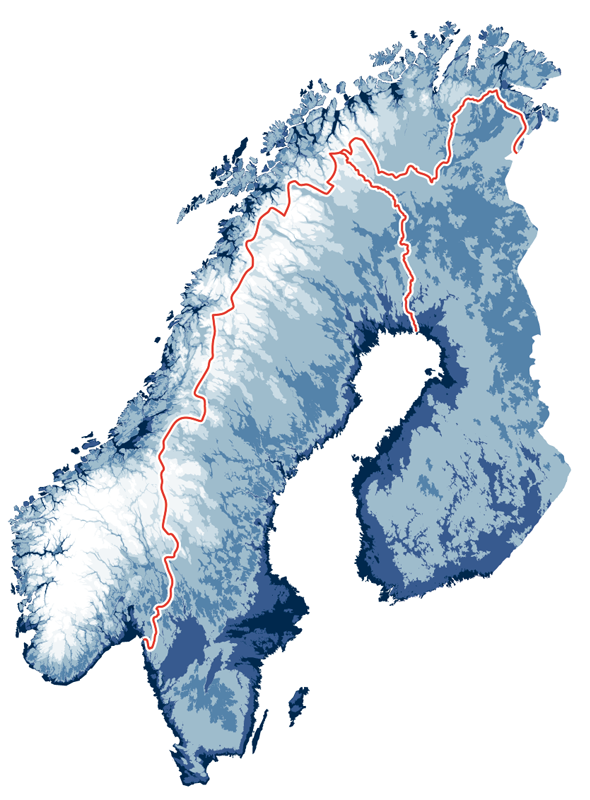
Area of the Marmota Map SKI RESORTS OF SCANDINAVIA without Denmark and with all of Finland.

